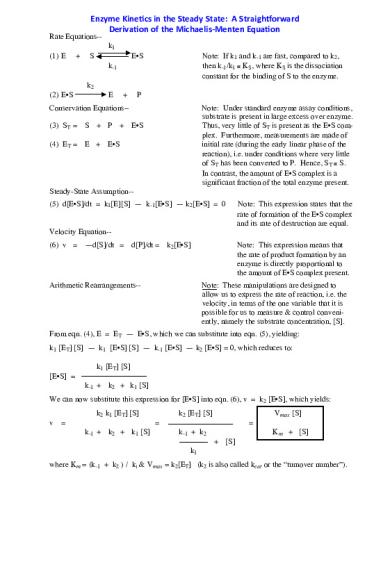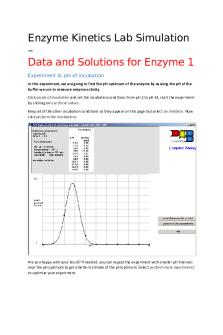Enzyme kinetics- the Michaelis-Menten equation PDF

| Title | Enzyme kinetics- the Michaelis-Menten equation |
|---|---|
| Author | Kay Choi |
| Course | Biochemistry |
| Institution | University of California, Berkeley |
| Pages | 1 |
| File Size | 63.1 KB |
| File Type | |
| Total Downloads | 99 |
| Total Views | 159 |
Summary
Download Enzyme kinetics- the Michaelis-Menten equation PDF
Description
Enzyme'Kine*cs'in'the'Steady'State:''A'Straigh6orward' Deriva*on'of'the'Michaelis>Menten'Equa*on'
Rate Equations--
k1 (1) E
+
S
Note: If k1 and k-1 are fast, compared to k2, then k-1/k1 ! KS, where KS is the dissociation constant for the binding of S to the enzyme.
E•S k-1
k2 (2) E•S
E
+
P
Conservation Equations--
Note: Under standard enzyme assay conditions, substrate is present in large excess over enzyme. Thus, very little of ST is present as the E•S complex. Furthermore, measurements are made of initial rate (during the early linear phase of the reaction), i.e. under conditions where very little of ST has been converted to P. Hence, ST ! S. In contrast, the amount of E•S complex is a significant fraction of the total enzyme present.
(3) ST = S + P + E•S (4) ET = E + E•S
Steady-State Assumption-(5) d[E•S]/dt = k1[E][S] — k-1[E•S] — k2[E•S] = 0
Note: This expression states that the rate of formation of the E•S complex and its rate of destruction are equal.
Velocity Equation-(6) v = —d[S]/dt = d[P]/dt = k2[E•S]
Arithmetic Rearrangements--
Note: This expression means that the rate of product formation by an enzyme is directly proportional to the amount of E•S complex present. Note: These manipulations are designed to allow us to express the rate of reaction, i.e. the velocity, in terms of the one variable that it is possible for us to measure & control conveniently, namely the substrate concentration, [S].
From eqn. (4), E = ET — E•S, which we can substitute into eqn. (5), yielding: k1 [ET] [S] — k1 [E•S] [S] — k-1 [E•S] — k2 [E•S] = 0, which reduces to: k1 [ET] [S] [E•S] = k-1 + k2 + k1 [S] We can now substitute this expression for [E•S] into eqn. (6), v = k2 [E•S], which yields: k2 k1 [ET] [S] v =
k2 [ET] [S]
Vmax [S]
= k-1 + k2 + k1 [S]
= k-1 + k2
Km + [S] + [S]
k1 where Km = (k-1 + k2 ) / k1 & Vmax = k2[ET] (k2 is also called kcat or the “turnover number”)....
Similar Free PDFs

Mcat biochem Enzyme Kinetics
- 3 Pages

Tutorial Enzyme Kinetics
- 8 Pages

05 Enzyme kinetics - Worksheet
- 18 Pages

Lab #9 Enzyme Kinetics
- 10 Pages

Lab Report - Enzyme Kinetics
- 4 Pages

Enzyme Kinetics Lab Simulation
- 4 Pages

Enzyme Kinetics Lab Report
- 14 Pages

Enzyme Kinetics 5 - Lab report
- 8 Pages
Popular Institutions
- Tinajero National High School - Annex
- Politeknik Caltex Riau
- Yokohama City University
- SGT University
- University of Al-Qadisiyah
- Divine Word College of Vigan
- Techniek College Rotterdam
- Universidade de Santiago
- Universiti Teknologi MARA Cawangan Johor Kampus Pasir Gudang
- Poltekkes Kemenkes Yogyakarta
- Baguio City National High School
- Colegio san marcos
- preparatoria uno
- Centro de Bachillerato Tecnológico Industrial y de Servicios No. 107
- Dalian Maritime University
- Quang Trung Secondary School
- Colegio Tecnológico en Informática
- Corporación Regional de Educación Superior
- Grupo CEDVA
- Dar Al Uloom University
- Centro de Estudios Preuniversitarios de la Universidad Nacional de Ingeniería
- 上智大学
- Aakash International School, Nuna Majara
- San Felipe Neri Catholic School
- Kang Chiao International School - New Taipei City
- Misamis Occidental National High School
- Institución Educativa Escuela Normal Juan Ladrilleros
- Kolehiyo ng Pantukan
- Batanes State College
- Instituto Continental
- Sekolah Menengah Kejuruan Kesehatan Kaltara (Tarakan)
- Colegio de La Inmaculada Concepcion - Cebu







